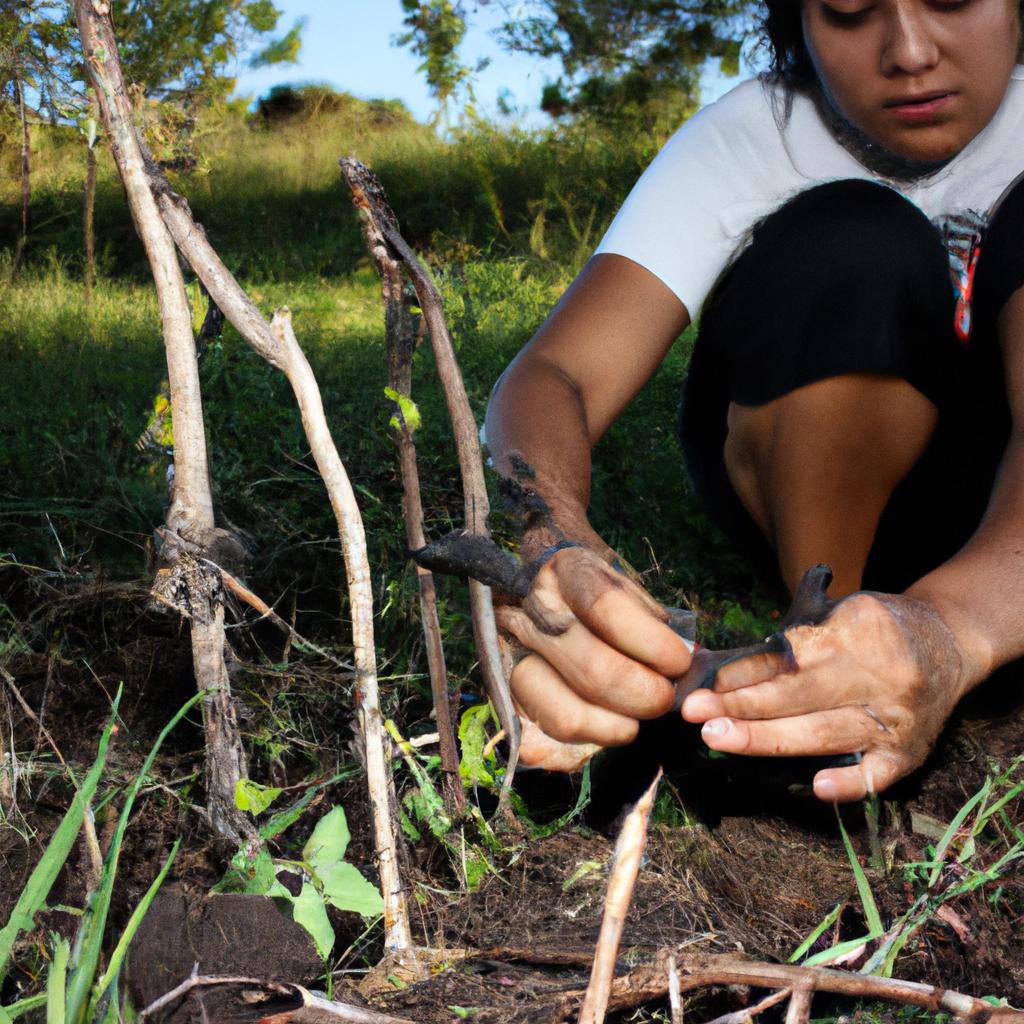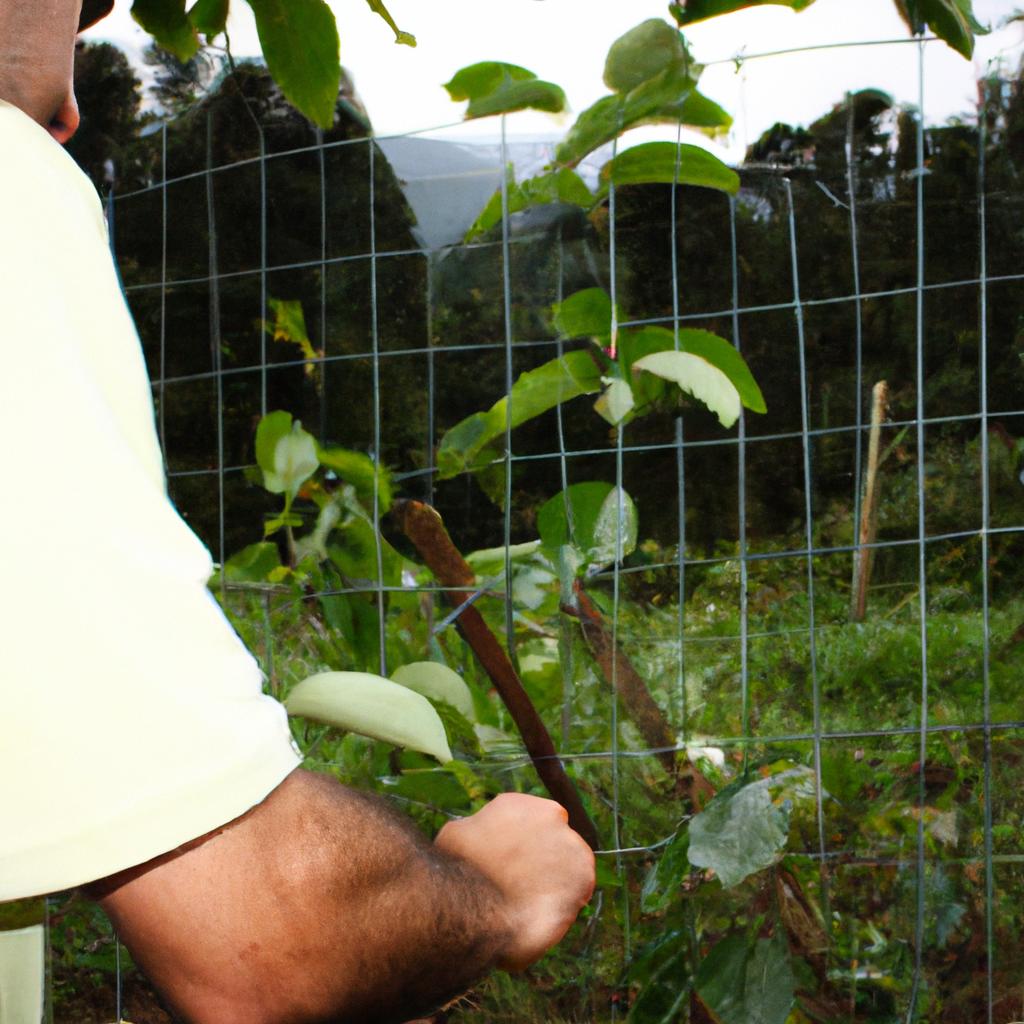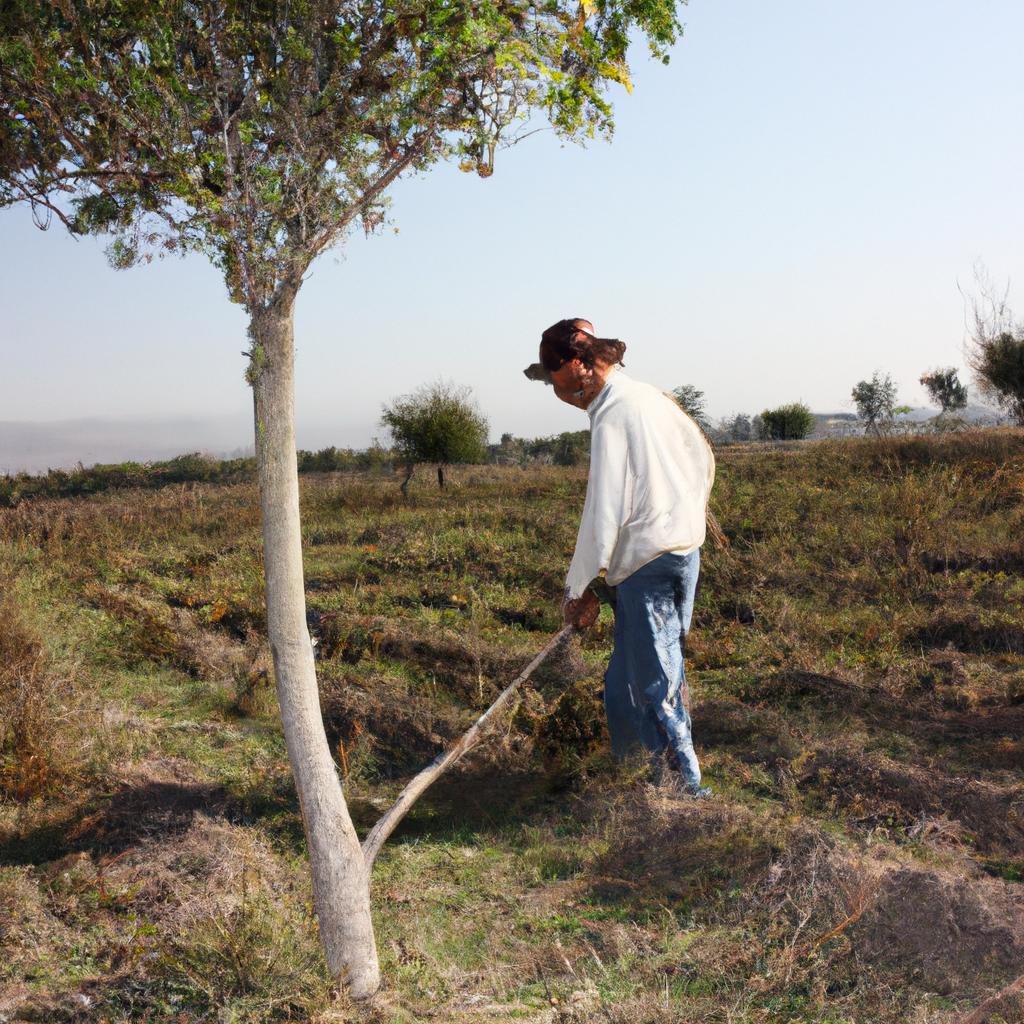Agroforestry systems have gained increasing recognition as a sustainable approach in both business agriculture and forestry sectors. This article aims to provide an informative overview of agroforestry systems, highlighting their importance, benefits, and potential challenges. By exploring the synergy between agricultural crops, trees, and livestock within a single system, agroforestry offers a multifunctional strategy that enhances productivity while promoting environmental conservation.
To illustrate the practical application of agroforestry systems, consider the case study of a hypothetical coffee farm in Central America. Traditionally, coffee farmers solely focused on cultivating coffee plants without considering the surrounding ecosystem’s impact. However, with the adoption of an agroforestry system, this hypothetical farm integrates shade-tolerant tree species alongside coffee cultivation. These trees not only provide shade for the delicate coffee plants but also serve as windbreaks and erosion control measures. Additionally, they create habitats for beneficial insects and birds that contribute to pest management—an essential aspect of sustainable farming practices. Through such integration, this hypothetical coffee farm demonstrates how agroforestry systems can maximize resource utilization while minimizing negative environmental impacts.
Overall, this article presents an academic exploration into the realm of agroforestry systems in business agriculture and forestry by shedding light on their importance, benefits, and potential challenges. Agroforestry systems are crucial in promoting sustainable agriculture and forestry practices by integrating agricultural crops, trees, and livestock within a single system. This integration enhances productivity, conserves the environment, and promotes biodiversity.
One of the primary importance of agroforestry systems is their ability to improve soil health and fertility. Trees in these systems contribute organic matter through leaf litter, which enriches the soil with essential nutrients. The tree roots also help maintain soil structure, prevent erosion, and reduce nutrient leaching.
Agroforestry systems also provide multiple sources of income for farmers. By diversifying their production through intercropping or integrating livestock into their farming system, farmers can have additional revenue streams. This reduces their reliance on a single crop or product and increases their resilience to market fluctuations.
Environmental conservation is another significant benefit of agroforestry systems. The integration of trees helps sequester carbon dioxide from the atmosphere, mitigating climate change impacts. These systems also promote biodiversity by creating habitats for various plant and animal species.
However, implementing agroforestry systems does come with challenges. Farmers may face initial investment costs when transitioning from traditional monoculture practices to agroforestry systems. They may require training or technical support to understand the complexities of managing diverse crops and trees together effectively.
Additionally, there might be limited market demand or infrastructure for products derived from agroforestry systems. Creating awareness among consumers about the environmental benefits of such products becomes crucial in developing a sustainable market for them.
In conclusion, agroforestry systems offer a sustainable approach to business agriculture and forestry by integrating crops, trees, and livestock within a single system. Their importance lies in improving soil health, providing multiple income sources for farmers while conserving the environment. However, challenges such as initial costs and limited market demand need to be addressed to maximize the adoption and impact of agroforestry systems.
Benefits of Agroforestry Systems
One real-life example that illustrates the benefits of agroforestry systems is the case study of a small-scale farmer in a rural community. This farmer decided to implement an agroforestry system on their land, combining the cultivation of crops with the planting and management of trees. By doing so, they were able to reap several advantages that positively impacted both their agricultural production and overall livelihood.
Firstly, one significant benefit of agroforestry systems is increased biodiversity. The integration of trees within crop fields provides additional habitat for various forms of wildlife, such as birds and insects. This promotes ecological balance and enhances pollination services, resulting in higher yields for the farmer’s crop production. Moreover, this diverse ecosystem contributes to improved soil health by increasing organic matter content and nutrient cycling.
Secondly, agroforestry systems offer economic advantages through diversified income streams. In addition to traditional crop revenues, farmers can generate supplementary income from selling timber or non-timber forest products obtained from managed tree species within their agroforestry plots. This diversification not only reduces dependency on a single source of income but also provides resilience against market fluctuations or crop failures.
Furthermore, adopting agroforestry practices has been proven to mitigate climate change impacts by sequestering carbon dioxide from the atmosphere. Trees act as natural carbon sinks, helping reduce greenhouse gas emissions and combatting global warming. Additionally, these systems contribute to better water regulation within farmland by reducing runoff and erosion rates while improving water infiltration into soils.
To summarize:
- Increased biodiversity: Agroforestry systems support diverse ecosystems that enhance pollination services, leading to higher crop yields and improved soil health.
- Diversified income streams: Farmers can generate additional revenue through timber sales or other forest products alongside traditional crops.
- Climate change mitigation: Agroforestry acts as a natural carbon sink, aiding in reducing greenhouse gas emissions and regulating water flow within farmland.
In the subsequent section, we will explore different types of agroforestry systems that can be implemented to harness these benefits.
Types of Agroforestry Systems
Agroforestry systems offer a range of benefits that make them an attractive option for farmers and land managers. By integrating trees into agricultural or forestry practices, these systems provide numerous advantages in terms of environmental sustainability, economic viability, and social well-being.
One example that highlights the benefits of agroforestry is the case study conducted on a farm located in a rural community in Brazil. The farmer decided to implement an agroforestry system by planting fruit trees alongside their traditional crop cultivation. This integration not only increased the overall productivity of the farm but also improved soil fertility and water retention due to the tree roots’ ability to stabilize the soil structure.
The advantages offered by agroforestry systems can be summarized as follows:
- Biodiversity conservation: By incorporating diverse plant species into farming practices, agroforestry systems contribute to the preservation of biodiversity. Trees provide habitats for various wildlife species, including birds, insects, and small mammals. Moreover, such systems help protect native flora and fauna by reducing habitat loss caused by deforestation.
- Climate change mitigation: Agroforestry plays a crucial role in mitigating climate change impacts. Trees act as carbon sinks, sequestering atmospheric CO2 through photosynthesis. Additionally, they provide shade and windbreaks that help regulate temperature extremes and reduce evaporation rates from soils.
- Economic diversification: Agroforestry offers opportunities for diversified income streams through multiple products obtained from trees and crops. Farmers can sell timber, fruits, nuts, medicinal plants, or even honey derived from bees attracted to flowering trees within their agroforestry system.
- Social resilience: Agroforestry contributes to building resilient communities by improving food security and providing additional sources of income. These systems enhance local livelihoods while promoting sustainable natural resource management.
To further illustrate these benefits:
| Benefit | Description |
|---|---|
| Biodiversity conservation | Agroforestry systems promote habitat creation and biodiversity preservation. Trees provide nesting sites for birds and shelter for small mammals. |
| Climate change mitigation | Trees sequester carbon dioxide, regulate temperatures, and reduce soil evaporation rates. |
| Economic diversification | Additional income streams can be generated through the sale of timber, fruits, nuts, medicinal plants, or honey. |
| Social resilience | Agroforestry enhances food security and provides sustainable livelihoods to local communities. |
In summary, agroforestry systems offer a multitude of benefits ranging from ecological sustainability to economic prosperity and social well-being. By integrating trees into agricultural or forestry practices, these systems contribute to biodiversity conservation, climate change mitigation, economic diversification, and social resilience.
The next section will delve into the different types of agroforestry systems that farmers can adopt to maximize their land’s potential while reaping these benefits without compromising productivity.
Transitioning into the subsequent section about “Integration of Trees and Crops in Agroforestry,” we now explore how trees can effectively be integrated with crops within agroforestry systems.
Integration of Trees and Crops in Agroforestry
Agroforestry systems offer diverse ways of integrating trees and crops for sustainable agricultural practices. In this section, we will explore the various ways in which trees can be incorporated into agroforestry systems to enhance productivity and environmental resilience. One example of an agroforestry system is the alley cropping method, where rows of trees are planted alongside crop fields.
One key benefit of integrating trees and crops in agroforestry systems is the improved microclimate they create. The presence of trees provides shade, reducing soil temperature and water evaporation, thus creating a more favorable environment for crop growth. Additionally, tree roots contribute to soil structure by enhancing its water-holding capacity and nutrient cycling capabilities. This ultimately leads to increased soil fertility and reduced erosion risks.
Furthermore, incorporating trees into agroforestry systems promotes biodiversity conservation. Trees provide habitats for various wildlife species and support pollinators crucial for crop production. By diversifying plant species within agroforestry systems, farmers can foster ecological balance and reduce pest pressures without relying heavily on synthetic pesticides or herbicides.
- Enhanced food security through diversified farming practices.
- Improved climate change mitigation by sequestering carbon dioxide.
- Better adaptation to extreme weather events due to enhanced ecosystem resilience.
- Increased income opportunities through value-added products derived from both trees and crops.
In addition, let us present a three-column table showcasing different types of agroforestry systems along with their associated advantages:
| Agroforestry System | Advantages |
|---|---|
| Alley Cropping | Reduced erosion risks; Increased soil fertility |
| Silvopasture | Improved livestock welfare; Enhanced land productivity |
| Windbreaks | Protection against wind damage; Reduction in energy costs |
As we delve deeper into exploring the possibilities of agroforestry systems, we will now transition to the subsequent section about “Economic Opportunities in Agroforestry.” Through understanding the economic advantages that can be derived from these systems, we can further appreciate their potential for sustainable development and profitability.
Economic Opportunities in Agroforestry
Agroforestry, the intentional integration of trees and crops on the same land, offers various economic opportunities for businesses in agriculture and forestry. This section will explore some key aspects of agroforestry systems that contribute to their potential profitability.
One example of a successful agroforestry system is the combination of coffee cultivation with shade trees. In this system, farmers strategically plant shade-providing tree species alongside coffee plants. The shade trees not only protect the coffee plants from excessive sunlight but also provide additional benefits such as nutrient cycling, pest control, and soil conservation. By integrating these two elements, farmers can enhance the overall productivity and quality of their coffee crop while reducing input costs associated with artificial shading methods or synthetic fertilizers.
The economic advantages offered by agroforestry systems extend beyond individual case studies. Here are several reasons why businesses should consider incorporating agroforestry practices into their operations:
- Diversification: Agroforestry allows for diversification both within a single farm and across multiple farms engaged in supply chain collaborations. By including different tree species along with cash crops, businesses can mitigate risks associated with market fluctuations or climate change impacts affecting specific commodities.
- Value-added products: Agroforestry enables the production of value-added products derived from both agricultural crops and harvested timber resources. These diversified product lines provide businesses with opportunities to tap into niche markets and increase revenue streams.
- Ecosystem services: Agroforestry enhances ecosystem services such as carbon sequestration, water filtration, wildlife habitat provision, and erosion control. These ecological functions have societal values that could potentially be monetized through mechanisms like carbon credits or eco-tourism ventures.
- Social impact: Agroforestry systems often involve community engagement and participation. Such initiatives promote sustainable livelihoods for rural communities by generating employment opportunities and fostering local entrepreneurship.
By capitalizing on these economic opportunities, businesses in agriculture and forestry can not only achieve financial success but also contribute to sustainable development goals. The next section will delve into the environmental impacts of agroforestry, highlighting further benefits associated with these integrated systems.
Environmental Impacts of Agroforestry
Having discussed the economic opportunities that agroforestry presents, we now turn our attention to the environmental impacts associated with this farming practice. Understanding these implications is crucial for sustainable land management and conservation efforts.
Environmental Impact Case Study:
To illustrate the diverse effects of agroforestry on the environment, let us consider a hypothetical case study involving a small-scale coffee farm in Central America. In this scenario, farmers have implemented an agroforestry system where shade trees are planted alongside their coffee plants. This approach not only provides additional income through timber harvesting but also offers several ecological benefits.
Positive Environmental Aspects:
Agroforestry systems contribute positively to biodiversity conservation by creating habitats that support a wide range of plant and animal species. The presence of shade trees can enhance local flora diversity and provide refuge for various bird species. Additionally, these systems promote soil health through improved nutrient cycling and erosion control mechanisms facilitated by tree roots.
Negative Environmental Aspects:
While there are numerous positive aspects, it is important to acknowledge potential negative environmental impacts as well. One concern is competition between crops and trees for resources such as water and nutrients, which may affect productivity if not managed properly. Furthermore, improper selection or placement of tree species within the system can result in increased pest pressure or hinder crop growth due to shading effects.
Emotional Bullet Points:
- Protects biodiversity
- Enhances soil quality
- Promotes wildlife habitat restoration
- Mitigates climate change impact
| Positive Impacts | Negative Impacts |
|---|---|
| Biodiversity conservation | Resource competition |
| Soil health improvement | Potential pest issues |
| Wildlife habitat creation | Crop growth limitations |
| Climate change mitigation |
Transition sentence into subsequent section:
Understanding both the positive and negative environmental consequences of agroforestry systems allows us to explore successful case studies in this field. By analyzing real-world examples, we can gain insights into the practical implementation and outcomes of such sustainable farming practices.
Successful Case Studies of Agroforestry Systems
Agroforestry systems offer numerous benefits, making them a valuable approach in business agriculture and forestry. One example is the successful implementation of agroforestry practices in a small-scale farm located in rural Nebraska. By integrating trees with crops and livestock, this farm has experienced increased sustainability and profitability.
There are several key advantages associated with agroforestry systems:
- Enhanced ecosystem services: Agroforestry promotes biodiversity by creating habitats for various plant and animal species. Trees provide shade, reduce soil erosion, improve water quality, and sequester carbon dioxide from the atmosphere.
- Improved soil fertility: In an agroforestry system, trees contribute organic matter to the soil through leaf litter and root exudates. This enhances nutrient cycling and increases overall soil fertility, leading to healthier crop growth.
- Diversification of income sources: Combining multiple agricultural activities within one system allows farmers to diversify their income sources. For instance, they can generate revenue from selling timber or non-timber forest products alongside traditional agricultural products.
- Climate change resilience: Agroforestry systems have shown potential in adapting to changing climatic conditions. The presence of trees provides natural windbreaks that protect crops against strong winds while also reducing evapotranspiration rates during drought periods.
To further illustrate the range of benefits offered by different types of agroforestry systems, consider the following table:
| Type of Agroforestry System | Key Benefit |
|---|---|
| Alley cropping | Increased crop yield due to improved water retention capacity provided by tree rows |
| Silvopasture | Enhanced forage availability for livestock through integration with woody perennials |
| Forest farming | Diverse income opportunities from cultivating specialty crops under a forest canopy |
Incorporating these diverse agroforestry systems into business agriculture and forestry practices can lead to both environmental and economic advantages. By harnessing the benefits of biodiversity, improved soil fertility, income diversification, and climate change resilience, businesses can foster sustainable development while ensuring long-term profitability.
Overall, it is evident that agroforestry systems offer a promising pathway towards achieving more environmentally friendly and economically viable agricultural practices. By implementing these systems effectively, businesses in the agriculture and forestry sectors can contribute to a greener future while simultaneously reaping numerous benefits for themselves and their communities.




